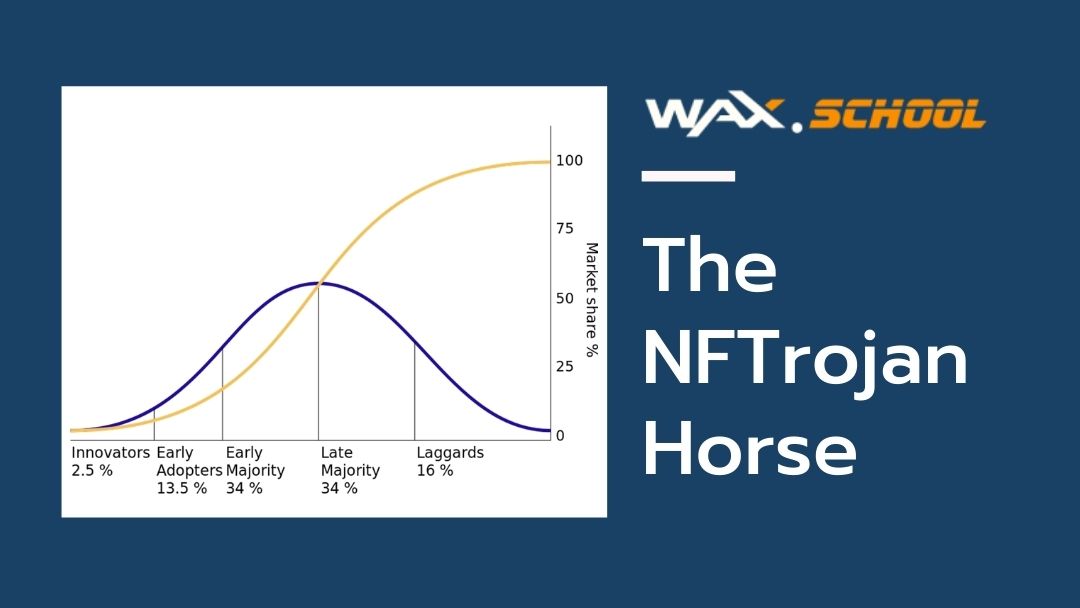An underexplored feature of NFTs is that they can create a means by which the merits of blockchain technology can be perceived by organisations which may be otherwise reluctant to commit more consequential procedures to an unproven technology. The rates at which new technologies are adopted have long been studied through diffusion of innovation theory. This seeks to analyse the forces at play which influence members of a social system in the adoption of new innovations, and to identify ways of speeding this process.
The American sociologist Everett M Rogers postulated that “most of the variance in the rate of adoption of innovations from 49 to 87 percent, is explained by five attributes: relative advantage, compatibility, complexity, trialability, and observability.” For many, the perceived complexity of blockchain technology, which in turn damages the perception of compatibility and trialability, and ultimately results in an environment where the benefits of the technology are not sufficiently observable to inspire confidence in would-be adopters. So, then how do we achieve concept penetration and build trust within new communities? With NFT-based projects, we can establish transferable use cases and assure functionality with low-risk projects.

The Music Industry and Blockchain Solutions
If we take the music industry as an example, we can focus in on an area where the integration of blockchain technology could significantly streamline and augment current activities. For our purposes here, we will look at gigs, and the royalties generated from these performances. If we then take this sector of the industry, and try to imagine a blockchain based project related to it which doesn’t directly affect the current way things operate, we can display compatibility, trialability, and observability of the technology with minimal risk to the prospective adopter.
In Europe alone, 28 collection societies collect royalties for public performance rights and mechanical recordings in 28 different markets. This means that each individual society must manage a large array of relationships, overcoming a diverse variety of problems ranging from interacting with unfamiliar databases and software, to simple interpersonal difficulties.
A significant stumbling block for artists and collections agencies stems from royalties generated from live performances of copyrighted works, and is founded on the difficulty of establishing trust between members and agencies, and consequently establishing the veracity of claims of performances. As it stands, members must log their performances with a collections agency, and then these performances must go through a review process before being verified.
Augmenting this process with the incorporation of blockchain technology could greatly increase its efficiency, eliminating the review process completely, and would make it impossible for fraudulent claims to be logged. This would protect musicians who are logging honest claims, and make the process by which they are paid for their work much swifter and less complicated.
For instance, a smart contract could be used to ascertain whether or not a gig actually happened. A smart contract is a computer protocol intended to digitally verify the performance of a contract. In this case, the parties involved – the organisation responsible for the venue in which a gig was performed, and the artist who performed the gig – must both agree that the gig happened. This would fulfill the contract, and this fulfilment would be safely recorded without the need for external validation from a third party. Of course, this would represent a huge change in procedure, and collection agencies would be understandably cautious about committing to an unproven – to them – technology.
An Alternative Approach to Building Trust
Let us then imagine an NFT issued upon attendance of an event. This creates a parallel system operating in the same field as royalty generation and collection, and dependent on the confirmation of the occurrence of the same events, but which does not interfere with the collection agency’s traditional operations. For this to be successful, it requires that the fact that the event has taken place must be confirmed, and for an individual’s attendance at the event be similarly verified. This can be easily accomplished via the methods stated above.
This provides fans with a chance to display their loyalty, and artists could then offer rewards based on the accumulation of a certain amount of collectibles. Fans could be offered exclusive music or artwork downloads, alternative versions of songs, or even meet and greets with the artist, based on a tiered system of concert attendance or merchandise purchase, with each transaction being represented by the possession of a collectible. As the collectible would be issued on blockchain technology, the complete transparency and immutability of the ownership record would reward legitimate interaction only, and prevent the system being exploited.
For the collection agency or artist, we have then proven the applicability of blockchain technology to the betterment of their current operations, while simultaneously creating a new incentive for event attendance, and a new avenue via which to engage with consumers.
This is just one example, but I believe with a little application of creativity, the concept can be transferred to other areas of industry, with NFTs creating opportunities to allay the concerns of hesitant adopters of new technologies, and ameliorate the historically slow rate of acceptance of new innovations.

